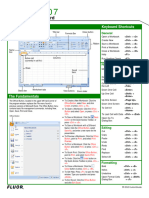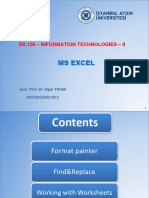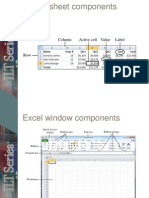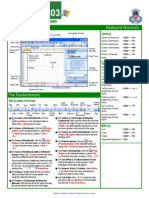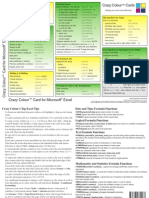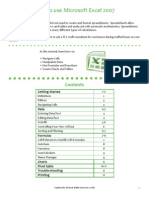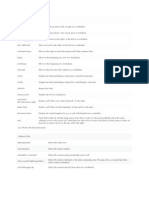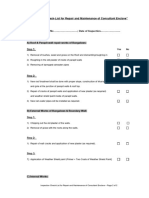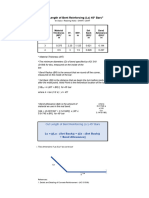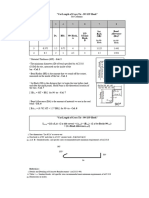0 ratings0% found this document useful (0 votes)
356 views6 pagesExcel Cheat Sheet PDF
Uploaded by
JAZPAKCopyright
© © All Rights Reserved
We take content rights seriously. If you suspect this is your content, claim it here.
Available Formats
Download as PDF or read online on Scribd
0 ratings0% found this document useful (0 votes)
356 views6 pagesExcel Cheat Sheet PDF
Uploaded by
JAZPAKCopyright
© © All Rights Reserved
We take content rights seriously. If you suspect this is your content, claim it here.
Available Formats
Download as PDF or read online on Scribd
You are on page 1/ 6
Microsoft®
Basic Skills
eases
Quick Access Toolbar Title Bar
Worksheet Tab
ernest)
Create a Workbook: Click the File
{al and select New or press Ctrl»
N.Double-click a workbook
pen a Workbook: Click the Fle tab
‘and select Open or press Ctl +0.
‘Select a recent file or navigate tothe
loeation where the leis saved.
Preview and Print a Workbook: Click
the File tab and select Print
Undo: Click the Unde button on
the Quiek Access Toor.
Redo or Repeat: Click the Redo
button onthe Quick Access Tool.
‘The button tums to Repeat once”
ceverythinghas been re-do
Use Zoom: Click and drag th zoom
stider tothe lator right.
Select a Col: Click a call ruse the
keyboard arrow keys to select
Selecta Cell Range: Click and drag
To slecta range of cells. Or, press
‘and hold down the Shift key while
using the arrow keys to move the
‘selection tothe last cola the range.
Excel Ch eat Sheet
Formula Bar Close Button
columns
Scroll Bars
Select an Entire Worksheet: Click the
Select Allbutton where the
column and ow headings meet
Select Non-Adjacent Cells: Click the
first cll oc cel range, hold down the
Ctrtkey, and select any non-acjacent
‘alloreall ange.
Cell Address: Calle are referenced by
the coordinates made from their
‘column letter and row number, such
ascell A, B2, etc
Ez
Sump toa Call: lickin the Name
Box. type the cel address you want
to got, and press Enter.
Chango Views: liek a View button in
the status ba. Or, click the View tab
land select a view.
Recover an Unsaved Workbook
Restart Excel. Ifa workbook can be
recovered, it wll appearin the
Document Recovery pane. Or, click
‘the Fle tab, click Recover unsaved
‘workbooks to open the pane, and
select a workbook from the pane.
ProjectCub!cle
Reece eget
‘Open a workbook tl +0
Create a new workbook ...Ctel +N
Save a workbook etl +S
Print a workbook cul +P
Close a workbook “cuts W
He an oA
Activate Tell Me field mom pt
Spel check, fas
Colette worksheets onoF
Create absolute reference ..F4
Move between C2ls mah 0,0,» Tab
Right one cell “Shift + Tab
Left one cell Enter
Down one cell “Shift + Enter
Up one cal Page Down
Down one screen Home
To ist cel of active row ..End
Enable End mOd€ vwonnnnttt + Home
To cell AL ‘ott + End
Tolast cell
oe
eat
a
Ea
fn
Ez aCel’s Contents: Selecta cell and lick in
the Formula Bar or double-click thecal Eat
‘the ces contents an press Enter
Clear a Ces Contents: Select the cals) and
reste Delete key: cick the Clear
‘button on the Home tab and select Clear o
Content.
Cato Copy Data: Sele eal) and etek the
cut Copy button onthe Home ab
Past Data: Sell the cell where you want to
paso the data and cick the Past button
{he Cpboara group onthe Home tab,
Preview an tem Before Pasting: Place the
Insertion point where you want to paste, click
‘the Paste button lst arrow nthe Clipboars
‘70up on tig Home tab, and hold the mouse
‘over apaste option to preview.
Paste Special: Selec the destination cll),
click the Paste button ist arrow in the
Clipboard groupton the Home ta, and select
Paste Special. Select an option and click OX
Move o Copy Cells Using rag and Orap
Select the cel) you want to move o copy,
postion the pointer over any border of the
elected calls), then drag ta the destination
calls. To copy, hold down the Ctl key before
starting to drag
Fin ana Replace Text Click the Find &
Select button, select Replace. Type the text
you want to fndin the Find what box. Type the
Feplacement text inthe Replace with box. Click
‘the Replace all or Replace button.
[Check Spelling Click the Review tab and click
‘the Spelling button. For each result, select
‘suggestion and click the Change Change
All bution, Orsick the Ignore/tgnore Alt
button
Insert a Column or Row: ight-c tothe right
ofthe column or below the ow you want to
Insert, Select Insert inthe menu, or click the
Insert button onthe Home a,
Delete Column or Row: Select the row or
columafeadings) you want to remove. Right
‘lick and select Delete from the contextual,
‘mentor ice the Delete button inte Cells
‘group onthe Home tab
Hide Rows or Columns: Self the rows or
columns you want hide, lick the Format
button onthe Home tab select Hide &
Unhide, and select Hide Rows 0° Hie
columns.
‘Change Call Alignment: Selec thecal) you
want to liga and cick a vertical alignment
‘batten ora horizontal alignment
baton the Aigner group onthe
Format Text: Use the commands inthe Font
{gF0up onthe Home fab or cick the dialog box
launcher in the Font group to open the dialog
bow
Format Values: Use the commands inthe
[Number group on the Home tab or click the
dlalog box launcher inthe Number group to
‘open the Format Celle ialog box.
Wrap Tex ina Cel: Select the cel) that
contain text you want to wrap and click the
Wrap Text bution onthe Home tab,
‘Merge Cells: Select the ells you want to
merge. Click the Merge & Center button list
arrow onthe Home tab and select aimerge
option.
Cell Borers and Shading: Select the cells) you
vant ta foxmat. Click the Borders button
Andfor the Fill Clor button and select an
Sption to apply to the selected cal
Copy Formatting withthe Format Painter:
Select the cells) withthe formatting you want
{ocopy. Click the Format Painter button in
the Clipboard group on the Home tab, Then,
solet the cols) you want to apply te copied
formatting to.
just Column With or Rove Height: Click and
rag the right border ofthe column header or
the Bottom border ofthe row header. Double
click te border ta AuIOF the column a row
according to its contents
Ener a Foxmola: Select the call where you want
telinsert the formula. Type = and enter he
formula using values, cell reterences,
operators, and functions Press Enter
Insert Function: Select the cell where you
want to enter the function and click the Insert
Funetion btn next othe formula bar.
Reference aCellina Formula: Type the cell
reference (for example, 88) inthe formula oF
lik he cel you want to reference
SUM Function: lick the cell where you want to
inser the total and click the Sum futon in
the Eating groupon the Home tab. Enter the
calls you want to total and press Ente.
MIN and AX Functions: Click the cel where
you want to place a minimum or maximum
vale fora gen ange. Clic the Sum
‘button list arrow on the Home tab and s@lect
either Min or Max. Ener the cell range you
want to reference, and press Ent
[COUNT Function: Click the cell where you want
toplace acount of the numberof cli ina
‘ange that contin numbers. Click the Sum.
button ist arrow on the Home tab and selects
Count Numbers, Enter the col ange you want
{orelerence, and press Enter
Complete a Series Using AutoFill Select the
cells that define the pattern ea series of
‘months or years. Cek and drag the fit hance
{o adjacent blanc cells to compete the series,
Insert an Image: Clik the Insert tab onthe
ribbon, click ether the Pitures Dating
Pictures fin inthe Illustrations group,
select the image you want to inset, and click
Insert.
Insert Shape: Click the Insert tb onthe
ribbon, click the Shapes buon inthe
Ilustratons group, and seléct the shape you
wish insert.
Hypetinks Testor Images: Select the text or
‘graphic you want to useas.a hyperlink. Click
the Insert tab, then click the Link button
Choose a typeof hyperinkin the lefBpane of
the Insert Hypetink dialog box. Flin the
necessary informational elds in the ight pane,
then click OK
Modify Object Properties and Alternative Text:
Right-click an object. Select Eat Alt Text in
the menu and make the necessary
‘modifications under the Properties and Alt Text
headings.
Insert New Worksheet: Click the Insert
Worksheet uation next tothe sheet tabs
below the active shee. Or, press Shift + FAA.
Delete a Worksheet: Right-click the sheet tab
‘and select Delete from the menu
Hide a Worksheet: ightclick the sheet tab
and solect Hide from the menu
Rename a Worksheet: Double-click the sheet
tab, enter anew name for the worksheet, and
presenter.
Change a Workshests Tab Color: Right-click
the sheet ta, select Tab Color, and choose
the color you want 0 apply.
Move or Copy a Worksheet: Click nd draga
worksheet tab left ight to move itto anew
location. Hold doven the Ctl key wile clicking
and dragging o copy the worksheet.
Switch Between Excl Windows: Click the
View tab, click the Switeh Windows
button and select the window you wanego
make active
Freeze Panes: Activate the cell where you want
to freeze the window, click the View tab onthe
ribbon, click the Freeze Panes button inthe
Window group, and select an option from the
Uist a
Select a Prin Area: Select the cll range you
want to rit, click the Page Layout tab on the
ribbon, click the Print Area button, and
Select Set Print Area,
(© 2021 CustomGuide, tre
Microsoft®
Excel Ch eat Sheet
Intermediate Skills
fees nc)
as
Title
Create a Chart Select thecal range that contains
{he data you want to chart. lick the Insert ab on
the ribbon. Click a chart tye button inthe Charts
group and select the chart you want inert
Move or Resize Chart: Selec the chart. Place
'sborder and, with the a
headed arrow showing click and dragto move
it Or, eick and Braga sizing handle tagesize
Change the Chart Type: Select the chart and cick
the Design tab. Click the Change Chart Type
button and seloct a diferent char.
Filter 2 Chart: With the chart you want titer
selected, click the Filter button next ot
Deselect te items you watt hide rom the chart
view and click the Apply button
Position a Chars Legend: Select the chart, click
the Chart Elements button, click the Legend
aon, and select pasion forthe legend,
Show or Hide Chat Elements: Select the chart
and click the Chat Elements button. Then,
Use the check boxes to show oride each
flement
Insert Trendline: Select the chart where you want
toadd a trendline. Click the Design tab onthe
ribbon and clk the Add Chart Element
button, Select Trendine ram the menu,
a
Chart Tite
Bon Voyage Excursions
Insert a Sparkline: Select the cells you want to
summarize Click the Insert tab and select the
sparkine you want to inset. Inthe Location Range
‘eld enter the cel or cal ange to place the
spariine and click OK.
Create a Dual Ase Chart Selat the cellrange you
rant tochartcickthe insert tab, click the
{Combo byron, and select a combo char type.
Set the Page size: lick the Page Layout tab,
Click the Size bation and select a page size.
Set the Print Ave: Select the celrange you want
‘opin. Click he Page Layout ra, cick the Print
‘Area tton, and select Set
Print Tiles, Gridines, and Headings: Click the
Page Layout tab. Click the Prin Tiles bon
and set which items you wish to print.
‘Adda Header or Footer: Click the Insert tab and
click the Header & Footer bliton. Complete the
header and footer feds.
Adjust Margins and Oventation Click the Page
Layout ib. Click the Margins bon to select
feamalist of common page margins. Click the
Orientation Seton o chooce Porta or
Landscape orientation
ProjectCub!cle
eae teas
Chart Types
sed to compare
cifecent values verialyside-by-
Sie. Each values represented in
the chart by a vertical bar
Une: Used to illustrate trends
‘overtime (days, months, years)
Each values plotted as & point
con the chart and values are
connected byline.
Pie: Usetl for showing values as
| apercentage ofa whole when a
the values add upto 100%. The
‘values for each tem are
‘represented by diferent coors,
a Bar Silat clu charts,
> | except they display informationin
FS horionta bars rather than in
vertical clurms,
‘rea: Similar ttine chars,
except the areas beneath the
>> ines are filled with color
XY (Scatter) Use to pot
*| clusters of values using single
Points. Multiple items can be
plotted by using different colores
points or itferent point symbols.
Stack active parting
11] eatin of toes, en
| as the high, low, and closing
pois or scorn da
Sura: self fii
1 ni cnn ten
thoset of ta Cols ad
Dates ent len tre
inte same ang
R
Data Labels: splay values from the cells
‘ofthe worksheet onthe plot area ofthe
chart
Data Table: A table added next tothe
cart that shows the worksheet data the
charts illustrating.
Error Bars: Help you quickly identity
standard deviations and eror margins.
‘rendlne: Identities the trend of the
current data, not actual values. Can also
identify forecasts for future data
Form
Absolute References: Absolute references
always refer tothe same cell,evenf the
formulas moved. In the formula bar, add dollar
Sans (§) tothe reerence you want to remain
absolute for example, $A841 makes the
column and row remain constant)
Name a Colo Range: Select the cells), click
‘the Name boxin the Formula bar, ype a name
forthe calor ange, and press Enter. Names
can be used n formulas instead of eal
addresses, for example: =B4™Rat
Reference Other Worksheets: To reference
another worksheet i-aformla, add an
‘exclamation point‘ ate the sheet name in
‘the formula, for example: =FebruarySalestB4,
Relerence Other Workbooks: To reference
anather workbook na formula, add brackets
“(around the file ame inthe formula, for
example:
ebruarySales.xlsxisheet1!$B84,
‘Order of Operations: When calculating
formula, Excel performs operations inthe
following order: Parentheses, Exponents,
Multiplication and Division, and finally Aktion
and Subtraction as they appear eft right)
Use this mnemonic davies to remember thems
Please Parentheses
Excuse Expononts
My Muttilcation
Dear Division
‘Aunt adsition
Sally Subtraction
concatenate Text: Use the CONCAT function
=CONCAT(text4,text2,..) 0 jon the text
‘iam multole cells inte a single cl. Use the
arguments within the function to define the text
{you want to combine as well a any spaces or
punctuation.
Payment Function: Use the PMT function
-=PMT(rate;nper;pv.) to calculate a loan
amount, Use the arguments within the funetion
terdetinethetoarrate, numberof periods, and
present value and Excel calculates the
payment amount
Date Functions: Date functions are used to ada
specific date toa cel Some common date
‘unetions in Excel include:
‘Date =OATE(Vear month day)
Display Worksheet Formulas: Click the
Formulas ab o the ribbon and then cick the
‘Show Formulas buton. Click the Show
Formulas bution again to tur off the
formulavew.
m
m
Export Data Click the Fle tab. At the lft,
{elect Export and click Change File Type,
Select the ie type you want to expor the data
toad click Save As,
Inport Oat: Click the Data tab on the cbbon
and click the Get Data button, Select the
Category and data type, and then the file you
‘want to import. Click Import, verily the
preview, and then click the Laad button,
Use the Quick Analysis Tool: Solect the col
‘ange you want to summarize lick the Quick
‘Analysis ution that appear. Select he
analysis tl you want to use. Choose rom
formatting, charts, totals, tables, or sparkines.
Curtne and Subtotal: Click the Data tab onthe
ribbon and click the Subtotal gon, Use
‘the gialog box to define which column you want
te sublatal and the caleulation you want to use
lek OK.
Use Flash Fil lickin the cll to the right ofthe
call) where you want to extract or combine
ata, Start typing the data in the columa, When
patterns recognized, Excel predicts the
‘emaining valves forthe column, Press Enter
to accept the Fash Fil valves,
‘create a Data Valiation Rul: Select the cells
you wantto validate Click the Bata tab and
{ik the Data Validation button, Click the
Allow ist aron and selectthe data you want
tallow, Set aditional validation criteria.
‘options and click OK.
Format a Cell Range asa Table: Select the
calls you want to apply table formating to, Click
‘the Format as Table taon inthe Syles
group ofthe Home tab and select a table
format from the gallery.
4 laevepes 3550 26425 37455
4 MéseoOF 20850 17200 27010
2 ars sa710 20,75 35840
6 Tokyo azs510 14750 12490
2 Teta 208,330 96260 128315,
Sort Data: Select acelin the column you want
ta sort. Click the Sort & Fitrvourton on the
Home tab, Select sort order oF select
{Custom Sort to define specific sort criteria,
Fer Oat: Click the filter arrow forthe
columa you want to filter. Uncheck the boxes
for any data you want to hide. Click OK.
[Ad Table Rows or Columns: Selet acelin
‘the row or colum next to where you want to
‘ad blankclls, liek the Insert ton list.
tro on the Home tab, Select ether Insert
Table Rows Above or Insert Table Columns.
totheLett,
Remove Duplicate Valves: Click ay clin the
table ae cick the Data t25on the ribbon. Clk
‘the Remove Duplicates betion. Select
hich eolumns you want to check for duplicates
andcliek OX
Insert a Sic With any cl in the table
solectod, click the Design tab onthe ribbon
Click the tnsert Stier byston. Select the
columns you want to uses slicers and lick
0K.
Table Style Options: Click any clin the table.
Click the Desig tab onthe ribbon and select
an option in the Table Style Options group.
Apply Conditional Formatting Select the calls
you want to format. On the Home tab, cick the
Conditional Formatting iiton. Select a
Conditional formatting category and then the
tule you want to use. Speciy the format to
apply and cick OK.
‘Apply Cll Styles: Select the col) you want to
format, On the Home tab, click the Cell Styles
button and selec a tye from the menu. You
Bp atco select New cell Style ta define a
custom sive
‘Apply @ Workbook Theme: Click he Page
Layout tab onthe ribbon Click he Themes py
button and select a theme from the menu
‘Addl a Cll Comment Click the cll where you
‘want to adda comment. Click the Revlew tab
fn the bon and cick he New Comment | (3
button. Type your comment and then click
outside of to save the tet,
Invite People to Collaborate: Click the Share
button onthe bon, Ener the emai adress
of people you want to share the workbook with
{lick the permissions button, select a
permission level and click Apply. Typea short
ressage and click Send
Co-author Workbooks When another user
opens the workbook, click the user's picture or
intial on the rion, to see what they are
ting. Cells being edited by others appear
‘th a eolored border or shading
Protect a Worksheet: Before protecting a
worksheet, you need to unlock ay cells you
‘want to remain editable ater the protection is
applied. Then, click the Review tab onthe
ribo and click the Protect Sheet button.
Select what you want fo remain edie ater
the sheets protected.
‘Add a Workbook Password: Click the File tab
and select Save As. lick Browse to select a
‘save location. Click the Tools button inthe
Galog box and select General Options. Set a
‘password to. open and/or modity the workbook.
lek ox
Microsoft®
Advanced Skills
PivotTable Elements
Active PivotTable
Create a Pivot Table: Select the data range to be
Used bythe PvotTable. Click the Insert tab on
theribbon and cick the PiotTable fon in
the Tables group. Verify the range and tha click
ok.
‘Add Multiple PivotTable Feld: Click field inthe
fic tistand-dragit tone ofthe four PotTable
eas that contains one or more fields.
Filter PiotTables: Click and raga fe from the
fiat Uet cote Filters area. Clik the fea list
arrow above tho PivotTable and select the
value(s} you want ofiter.
Group PivotTable Values: Select acelin the
PivotTable that canainsa value you want to
f0up by. Ck the Analyze tab onthe ribbon
2nd click the Group Field button. Speciy how
the PivotTable shouldbe grped and then click
ok.
Refresh a PiotTable: With the PvotTable
Selected, click the Analyze ta onthe ribbon.
Chick the Refresh tutton inthe Data group,
Foxmat PivotTabl2 with the PhotTable
selected, click the Design ab. Then, select
desired formatting options rom the PvtTable
Options group andthe PivotTable Styles group
Excel Ch eat Sheet
PivotTable Fields
Pane
Search PivotTable| nf Pane
Fields Options.
Tools
Menu
Fiele
st
pelea
PivotTable Feld
‘reas
Create a PivChart lick any celina PiotTable
and cick the Analyze tab onthe ribbon. Click the
PivotChart gon inthe Toos group. Selecta
PivotChart type and click OK
oy PivtChart Data: Drag fields into and out of
‘he tiete areas the task pane,
Refresh PiotChart: With the PhotChart selected,
tick he Analyze tah on tho rsbon. Click the
Refresh button in the Data group.
oly PivotChart Elements: With he PvotChart
elated, click the Desig tab on the ribbon. Click
the Add Chart Element button in the Chart
laments group and sole the items) you want to
add tothe char,
Apply PuotChart Style: Select the PivotChart and
‘lckthe Design ab onthe ribbon. Select a style
from the gallery inthe Chart Styles group.
Update Chart Type: With the PivotChart selected,
ctrek the Design tab onthe ribbon. Click the
Change Chart Type bution inthe Type group.
Select anew chart typeand cick OK.
Enable ivotChart Drill Down: Click the Analyze
tab, Click the Feld Buttons lst arrow in the
Show/Hide group and select Show
Expand/Collapse Entire Field Buttons.
ProjectCub!cle
MEW Ca eat
PES Ce ae
‘The PivotTable Fields pane controls how
datais represented in the PivotTable
Click anywhere in the PuotTable to
activate the pane. It includes a Search
field a scrling lst of fields these are
the column heasings inthe data range
Used to ereate the Pot Table, and four
‘areas in which fields ar place These
Tour areas include
Ftrs: It field is placed in the
"Y._ Filters area, a menu appears above
‘the PiotTable. Each unique value
from the fld isan tem inthe
‘menu, which can be used to filter
PivotTable data
‘Column Labels: Tho unique
jes forthe ilds placed in the
imas area appear as clumn
headings along the topo the
Pivotrabie
Row Labels: The unique values for
thadilds placed in the Rows area
appear as row headings along the
let side of the PuorTable
Values: The values are the “meat
ofthe PvotTable, or the actual data
thats calculated forthe fetds
placed in the rows and/or columns
area, Values are most often
‘umeric calculations,
‘Not all Pivot Tables wil havea fildin
‘each area, and sometimes there wil be
‘multiple fieldsina single ace
Subtotals Grand Report lank
+ Totals Layout Rows
Layout
‘Subtotals: Show or hide subtotals and
specity their location nthe PuotTable
Grand Totals: Ad or remove grand total
rons for columns andjor rows.
Report Layout: Adjust the report layout to
how in compact, outing, or tabular form,
‘Blank Rows: Emphasize groups of ata
by manually adding blank rows between
grouped tems
Enable the Developec Tab: Click the File tab
and select Options. Select Customize
bon athe let. Check the Developer
‘checkbox and click OK
Records Macro Click the Developer tab on
‘the ribbon and click the Record Macro
button Type a name and description the
‘peciy where to save it Cick OK. Complete
the stops tobe recorded, Click the Stop
cording byton on the Developer tb,
Runa Macro lek the Developer tab on the
ribbon and click the Macros button. Select
the macro andlick Run,
tit Macro: lek the Developer tab on the
ribbon and lick the Macros button. Selecta
macro and click the Edt butt. Make the
recessary changes to the Visual Basic code
and click the Save button.
Delete a Macro: Click the Developer tab on
‘the ribbon and click the Macros b
Select a macro al click the Delete buton,
Macro Security: Click the Developer ab on
the ribbon and click the Macro Security
button, Select a security evel and click OK
Common Formula Error:
= en - The column ie wide enough to
display all cell data,
“NAME? - The text inthe formula ent
recognizes
+ VALUE! - Theres an error with one or
more formula arguments
+ HDIV/O- The formula is tryng to divide a
value by 0,
“+ HREFL- The formula references a cell that
no longer exists
‘Trace Precedents: lick the cell containing the
value you want 0 trace and click the Formulas
tab onthe ribbon, Click the Trace Precedents
‘utton to see which ells alec the valuein
{he selected cl,
Jan Feb Total
tan Ro
see —— ae
Eror Checking: Selecta cll containingan
‘error. Click the Formulas tb onthe ribbon
land click the Eror Checking button the
Forma Auditing group. Use théialog to
locate and fox the ero.
‘The Watch Window: Select the cell ou want to
\watch. lick he Formulas tab onthe ridbon
and click the Wateh Window button, Click
the Add Watch buon. Ensuretie correct
cells identified a lick Add
Evaluate a Formula: Selet ace witha
formula Clic the Formulas tab onthe ibbon
sk the Evaluate Formato,
Customize Conditional Formatting: Click the
Concitional Formatting Botton onthe
Home tab and select New Rule Selecta rule
type, then edt the styles and values. Click OK.
Edit Conditional Formatting Rule: Click the
Conditional Formatting byton on the
Home tb and select Manage Rules. Select the
rule you want o edit and cok Et Rule. Make
your changes tothe rule, Click OK.
Change the Order of Conditional Formatting
button on the Home tab and select Manage
Rules. Select the rule you want tore-sequence.
Click the Move Up or Move Down arrow
Unf the rules positioned correcty. lick OK.
‘Goal Seok liek the Data tb onthe ribbon,
Click tne what-It Analysis ition and select
Goal Seek. Specify the desied value for the
ven cell and which cell can be changed to
Feach the desied rest Click OK.
‘Nested Functions: A nested function is when
fone function is tueked inside another function as
‘ane ofits arguments, ice this
‘SIF (D2>AVERAGE(B2:B10), 1,0)
"AVERAGE (22310)
tia
Function
"Nested Function
IF: Performs logieal tet to return ane value for
‘true result, and anather for fale result
=1F(22269," False")
logical test value HLtrue value false
ttateanbe valvetoretim vale orem
frauned ¢ when the test's when totes
wert ae ‘ase
AND, Of NOT: Often used with IF to support
‘multiple conditions.
+ AND requires multiple conditions
+ OR accopts several ferent conditions.
+ NOT retums the opposite ofthe condition.
yk (BS="MN" ,BS="WI")
foghealt ett
conden to evatate
logieaa the second
condtion a evaate
SUMIF and AVERAGEIF: Calculates cells that
meet a canton.
+ SUMIF finds the total.
+ AVERAGEIF finds the average.
SUMIP(C6:C10,"
b6:D10)
ange ofceksenterlausedto_eale range to
youwant spay determee what cleus
‘era aganat cele to senor ile than the
Senge range
LOOKUP: Looks far and ret
specfc column in a table.
FNS -#)
value olbok_ table rom ies eo. Index tie
Ioeinthe frst fereneve aval column number
cohen othe thetabe rom
table when to retreve
LOOKUP: Looks for and retrieves data froma
specfc row ina table.
=HLOOKUP(BS,82:13,3)
valu ook table romhich row Index he
[Erin fet_toreneve avaue row umber the
row able Table for wich
UPPER, LOWER, and PROPER: Changes how
twxtis capitalized.
UPPER Case | lowor case | Proper Case
=UPPER(B4)
toxt to change case
‘or capitalization
LEFT and RIGHT: Extracts gen numberof
characters from the lator ht
JEPT(B5,3
text fiom which io pum_ehars to extract
extract characters from the eto right sce
ofthe text
MID: Extracts a given number of characters
‘rom the midale of text; the example below
would rerun "ay"
nro Sunday" 4,3)
arb cua
text rom which start num — num ehars ne
Noextact estan atthe number of
characters fsteharacerto characters
NATCHE Locates the psition of lokup value
ina row orealumn.
WATCH ( "Dog" ,B2:B10)
Yookup value io iatch lookup array range
inthe lokup_array of cells
INDEX: Returns a value or the reference to a
‘value from within a range.
ema
array 2range row.num the col num the
‘feels row poston column pasion
‘optona)
You might also like
- Edit A Workbook Basic Formatting Insert Objects: Topic LinksNo ratings yetEdit A Workbook Basic Formatting Insert Objects: Topic Links1 page
- Range Formulas and Functions: Microsoft ExcelNo ratings yetRange Formulas and Functions: Microsoft Excel18 pages
- LO 1.3 Modify Cell Structures and FormatsNo ratings yetLO 1.3 Modify Cell Structures and Formats57 pages
- Quick Guide For Excel 2013 Basics - February 2013 Training: Http://ipfw - Edu/trainingNo ratings yetQuick Guide For Excel 2013 Basics - February 2013 Training: Http://ipfw - Edu/training4 pages
- Microsoft Excel Shortcuts (Windows) : 1 Navigate Inside WorksheetsNo ratings yetMicrosoft Excel Shortcuts (Windows) : 1 Navigate Inside Worksheets9 pages
- Excel Basics: Workbook and Functions GuideNo ratings yetExcel Basics: Workbook and Functions Guide40 pages
- Icrosoft Xcel Tutorial: I U G (IUG) F E C E D I T C LNo ratings yetIcrosoft Xcel Tutorial: I U G (IUG) F E C E D I T C L41 pages
- ? Key Steps For Processing A Variation Order Under FIDIC 2017 Red BookNo ratings yet? Key Steps For Processing A Variation Order Under FIDIC 2017 Red Book3 pages
- ? Understanding Incoterms in Global Trade ?No ratings yet? Understanding Incoterms in Global Trade ?1 page
- Simplified Evaluation Example of Variation Under FIDIC 1999No ratings yetSimplified Evaluation Example of Variation Under FIDIC 19992 pages
- Claim Study - Review Under 2017 FIDIC For EPC ContractorNo ratings yetClaim Study - Review Under 2017 FIDIC For EPC Contractor1 page
- Time Bar Claim Notice Provisions Where ANo ratings yetTime Bar Claim Notice Provisions Where A57 pages
- TheFirstMegaProjectofPakistanManglaDamAzadJammuandKashmirAJKTarbelaDamanearth filleddamontheIndusRiverinKhyberPakhtunkhwaPakistanNo ratings yetTheFirstMegaProjectofPakistanManglaDamAzadJammuandKashmirAJKTarbelaDamanearth filleddamontheIndusRiverinKhyberPakhtunkhwaPakistan15 pages
- CCC ChangesToCRSIStandardBarBendDiametersNo ratings yetCCC ChangesToCRSIStandardBarBendDiameters2 pages
- O o o o o O: ACI 318-14 Crsi Standard Manual of Standard Practice All Dimensions in InchesNo ratings yetO o o o o O: ACI 318-14 Crsi Standard Manual of Standard Practice All Dimensions in Inches2 pages
- Mangla Refurbishment Project Salient FeaturesNo ratings yetMangla Refurbishment Project Salient Features7 pages
- 13-Quality Management & Quality AssuranceNo ratings yet13-Quality Management & Quality Assurance7 pages





